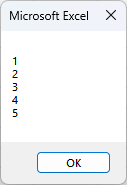Vbcrlf, also known as the “Visual Basic Carriage Return Line Feed”, is an essential built-in constant in the Visual Basic for Applications (VBA) programming language. This constant is chiefly used for creating new lines in VBA’s MsgBox or in the results of string operations, enabling programmers to manage and structure their outputs effectively.
The following tutorial provides a succinct explanation of how to use Vbcrlf in VBA. Every step has been carefully detailed to enhance your understanding.
Step 1: Basic Usage of Vbcrlf
Vbcrlf is remarkably easy to use, here’s a basic example:
|
1 2 3 |
Sub Example_1() MsgBox ("Hello" & VbCrLf & "World") End Sub |
In the code snippet above, “VbCrLf” is used to split “Hello” and “World” on two different lines in the MsgBox.

Step 2: Use of Vbcrlf with Loops
You can use Vbcrlf with loops like ‘For’ and ‘While’. It enables you to add new lines after each iteration. Here’s an example:
|
1 2 3 4 5 6 7 8 9 10 |
Sub Example_2() Dim i as Integer Dim msg as String For i = 1 to 5 msg = msg & i & VbCrLf Next i MsgBox msg End Sub |
In the code above, we are creating a loop from 1 to 5 and adding i & Vbcrlf to the msg string. This will place each new value of i on a new line in the MsgBox.

Step 3: Usage of Vbcrlf in String Operations
Vbcrlf proves handy in string operations. Here’s an example that concatenates two strings and places them on separate lines using the Vbcrlf:
|
1 2 3 4 5 6 7 8 9 10 11 |
Sub Example_3() Dim str1 As String Dim str2 As String Dim result As String str1 = "Hello" str2 = "World" result = str1 & vbcrlf & str2 MsgBox result End Sub |
In the code above, “Hello” and “World” would be displayed in the MsgBox on two separate lines.
Conclusion
As seen from the examples provided, Vbcrlf is an extremely useful tool in the Visual Basic Applications programming language. Its ability to create new lines in string outputs makes it an essential feature in the structuring and presentation of your codes’ results. To learn more about other constants in VBA, visit Microsoft’s official VBScript Constants page.
